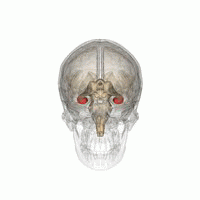
Photo from wikipedia
Abstract Persistent neuronal firing is often observed in working memory and temporal association tasks both in humans and animals, and is believed to retain necessary information in these tasks. We… Click to show full abstract
Abstract Persistent neuronal firing is often observed in working memory and temporal association tasks both in humans and animals, and is believed to retain necessary information in these tasks. We have reported that hippocampal CA1 pyramidal cells are able to support persistent firing through intrinsic mechanisms in the presence of cholinergic agonists. However, it still remains largely unknown how persistent firing is affected by the development of animals and aging. Using in vitro patch-clamp recordings from CA1 pyramidal cells in rat brain slices, we first show that the cellular excitability of these aged rats was significantly lower than that of the young rats, responding with fewer spikes to current injection. In addition, we found age-dependent modulations of input resistance, membrane capacitance, and spike width. However, persistent firing in aged (approximately two-year-old) rats was as strong as that in young animals, and the properties of persistent firing were very similar among different age groups. In addition, medium spike afterhyperpolarization potential (mAHP), was not increased by aging and did not correlate with the strength of persistent firing. Lastly, we estimated the depolarization current induced by the cholinergic activation. This current was proportional to the increased membrane capacitance of the aged group and was inversely correlated with their intrinsic excitability. These observations indicate that robust persistent firing can be maintained in aged rats despite reduced excitability, because of the increased amount of cholinergically induced positive current.
Journal Title: eNeuro
Year Published: 2023
Link to full text (if available)
Share on Social Media: Sign Up to like & get
recommendations!